| Manufacturer: | Scratch |
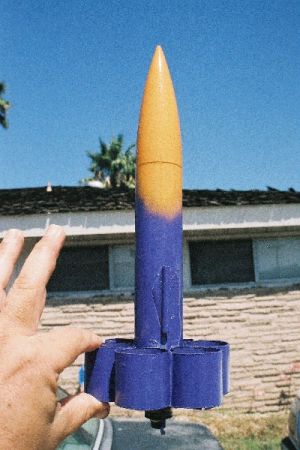
Brief:
This is a 100% kitbash of the Estes stormcaster, so I'm calling it a "scratch" build. I cut up the parts of
the C-D powered stormcaster to create an E-powered tubefin (it also flies on C-D motors). "E-Pod" is a
continuation (downward) of the H-Pod/I-Pod/J-Pod/K-Pod series of "extreme stubby" tubefin designs I have been
presenting in EMRR/Sport Rocketry/Rockets that uses the "stubbiness" rules I developed to
maximize tubefin performance (see Jan/March 2008 issues of Sport Rocketry). E-Pod is designed to fly at 400+ mph
on an Aerotech E30-7-- just don't try this on a stock stormcaster, folks!
Construction:
It starts out with the great Estes stormcaster kit, which is only $12.37 retail and excellent quality components.
It's much cheaper than buying components for E-Pod separately. A razor saw was used to cut up the two 38mm stormcaster
body tubes into a 7 3/8" body tube (use the pre-slotted section for this), and nine 1.5" sections for the 6
tube fins and the 6 half doublers. Motor tube assembly is used as is except that 4" of its length is cut away. I
substituted a 12" nylon chute (Top Flite) for the Estes plastic one, 24" of 1/8" para cord for the
signature Estes underpants elastic shock cord, and added an XS size Nomex®
protector.
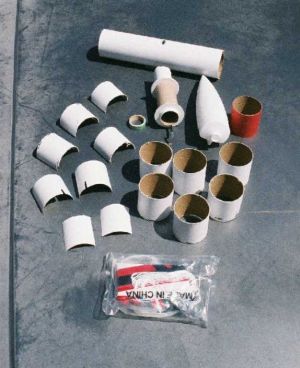
All assembly done with 5-min epoxy. Tube fins glued onto body tube in pairs in usual self-jigging tubefin fashion: on a flat surface, first two on opposite sides, then two on top, then turn assembly over and glue on the remaining two. The tube fin half-doublers made by bisecting the 3 extra tube fins are then epoxied to the inner surface of the outer half of each tube fin. This prevents the dreaded "tubefin flutter" at the 400+mph E-Pod will reach on an E-30. Cut-down, assembled Estes motor tube and centering ring arrangement was glued into the body tube with one modification--the red cardstock joiner tube used to connect the two stormcaster body halves was pushed into the body tube ahead of the motor tube assembly to lock it in place against E-power thrust stress. The usual Estes method of attaching the shock cord can not be used with this construction. Instead, I passed the para shock cord through a small hole 2 1/4" from the top of the body tube, anchored it with a knot, and covered the knot with a small, folded ramp-shaped fairing cut from a Rice Krispies box. The Estes launch lug was glued in place with its top 2" above the tubefins, and exactly in line with one of the triangular holes between two of the tube fins. Top of the launch lug is the CG balance point. You will choose a triangular hole that is not in line with the recovery knot fairing, and also is not blocked by epoxy that you slopped in there while gluing on the tube fins. The recovery system is attached to the nose cone in the normal way, that is by ignoring the useless, fragile plastic loop, cutting a second hole in the cone base, and tying it off with a secure knot.
Finishing:
Finish was with rattle-can yellow and purple Tamiya paint.
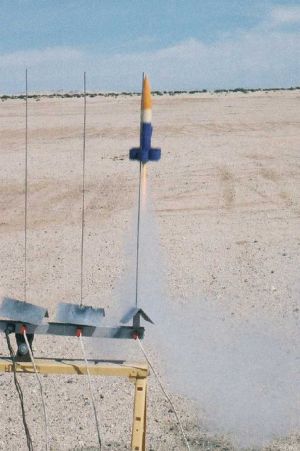
Flight:
First flight was on a D12-5 in winds blowing at just under the 20mph maximum. Not a good idea--E-Pod swapped ends
under power and landed about 1 second after motor ejection, cutting a small zipper. I fixed the zipper with a few wraps
of masking tape, added 29 grams of sand ballast through the nosecone base holes and taped them over. (How'd I decide on
29 grams? I added what seemed right and weighed E-Pod when I got home.) I tried again on the D12-5 (there was a little
less wind, too) and E-pod climbed flawlessly up to the 600-700' that simulations predicted. There was no damage on
recovery. Then I launched it on an E30-7 (4 sec delay is also OK) straight up to at least the 1300' predicted and out
of sight. A heck of a long walk to get it back with the 10-15 mph breeze blowing! Good thing others with better
eyesight could track the thing at that height. A fourth test flight on an C11-3 also went perfectly, except that the
wind caught it at about the 250-300' apogee, carried it horizontally a lot faster than I could run, and then dragged it
over desert gravel after touchdown for about a football field length or so until it tangled in a weed. (Well, I guess
there are technically no "weeds" in the desert, but it would be if it was in my front yard.) One of E-Pods
tube fins was ground half to death, so I replaced it with one cut from a cardstock tube from an empty roll of Saran
Wrap. When I got E-Pod home, I just spray painted over the masking tape repair with Tamiya yellow, making the temp
repair "permanent". Ditto for the grafted-on repair to the fin can. It flies regularly at our home field. The
29g sand ballast in probably not needed in calm conditions, but I just left it in there. I assume E-Pod would fly well
on RMS E28, E18 or F12 power, and I am going to try that next. The 115g weight includes the 29g sand ballast.
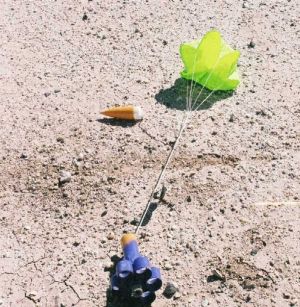
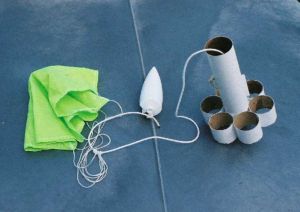
Summary:
PROs: A fun and eclectic little tubefin that takes advantage of new advances in tubefin aerodynamics, an unauthorized
addition to the Estes product line, if you want to do something different with their fine stormcaster kit. Flies very
well in windy conditions with the nose ballast. An easy $12.37 first scratch project for those who don't usually like
scratch building. Not many 12" long E-power rockets around.
CONs: Darn hard to track when flying on E30 power.
 |
 |